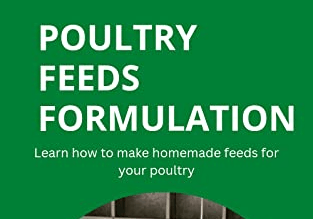Unlocking Success in Poultry Farming: The Art of Home-based Feed Formulation

Introduction
With the exception of a handful of feed manufacturers adhering to poultry feed standards, many companies in the country produce feeds of subpar quality, resulting in significant losses.
Inadequate feeds contribute to stunted chicken growth, diminished egg production, diseases, and even mortality. Crafting poultry feeds on the farm emerges as an optimal solution, offering a means to uphold quality while reducing production costs.


Key Ingredients:
The essential components for homemade poultry feed comprise whole maize, maize germ, cotton seed cake, soya beans, sunflower, or fish meal (omena). Accessible materials, especially post-harvest, make this method a cost-effective choice.
Incorporating Feed Additives:
In addition to the primary ingredients, farmers must introduce various feed additives such as micro-nutrients, minerals, and vitamins to ensure a balanced feed meeting daily nutrient requirements.
Cost-Efficiency:
Material availability, particularly after the harvest season, renders homemade feed formulation cost-effective. Depending on raw material costs, farmers practicing home-based feed production can save between 30% to 50% for every 70kg bag of chicken feed, contingent on their raw material sources.
Government Regulations and Feed Quantity:
Due to government regulations, major feed companies have reduced the standard quantity of feed from 70kg to 50kg per bag. Despite this reduction, the price of feed remains relatively unchanged. Consequently, farmers producing their own feeds experience substantial savings, considering that feed constitutes up to 80% of production costs.
Calculation of Crude Protein Content:
Using the calculated percentages of each ingredient, a farmer can ensure that the total crude protein content meets the required standard. For instance, a formulated feed may have a 19% crude protein content, suitable for layers.
Ready-Made Formulations:
Whole maize — 8.23%
Soya — 45%
Fishmeal (omena) — 55%
Maize bran — 7%
Sunflower — 35%
Each chicken category has distinct nutritional requirements. For layers, the feed should contain a minimum of 18% crude protein. To formulate feed for layers, farmers calculate the percentage of DCP in each ingredient, ensuring the total crude protein content meets the 18% standard.
Example Formulation for Layers (18% Crude Protein):
Ingredients for a 70kg bag:
- 34kg of whole maize
- 12kg of soya
- 8kg of omena (fishmeal)
- 10kg of maize bran
- 5kg Sunflower seed (as source of Omega 3 and 6 fats)
- 6kg of lime (as a calcium source)
Comprehensive Guide Facebook Post Link
For a more comprehensive guide please refer by 'CLICKING HERE' to our facebook post 'OWN FEED MIXES'
Verification of Crude Protein Content:
A simple calculation determines if the ingredients meet the 18% crude protein standard. For instance, the calculated crude protein content for the above formulation is 19%, adequately meeting the requirement for layers.
Additives for Nutrient Balance:
To ensure chickens receive essential nutrients such as vitamins, minerals, and amino acids, farmers need to include additives in standard quantities.
Pre-determined Formulations:
For simplicity, pre-determined feed formulations for each chicken category and growth stage are provided. Farmers only need to purchase the ingredients and mix them accordingly.
Conclusion
Crafting high-quality chicken feed at home emerges as a cost-effective and efficient solution for poultry farmers. By following the provided formulations and guidelines, farmers can embark on a journey towards sustainable and thriving poultry farming.

Welcome to the Poultry Universe Zimbabwe Blog! 🌐🐔
Established in 2014, we're dedicated to elevating poultry farming standards in Zimbabwe. 🚀 Join us for expert insights, industry trends, and a vibrant community of poultry enthusiasts. Whether you're a seasoned farmer or just starting, discover valuable knowledge and connect with like-minded individuals here. 📖✨ Welcome to the Poultry Universe community, where knowledge meets passion! 🌟🚜
JOIN OUR MAILING LIST
Authored by: Etwell Maphosa



